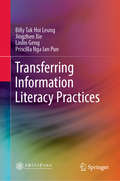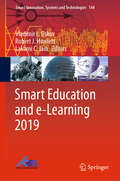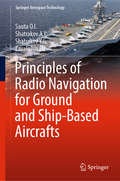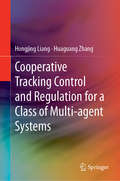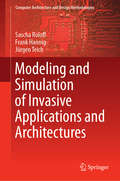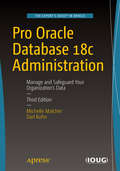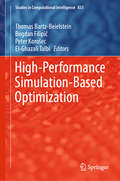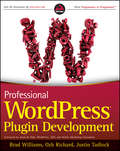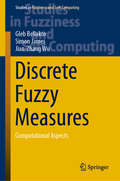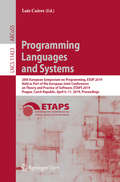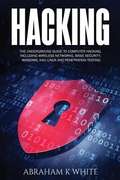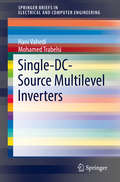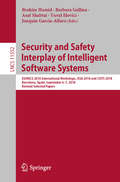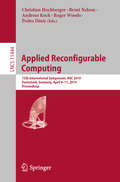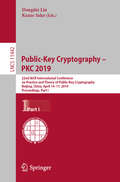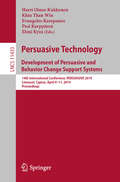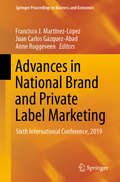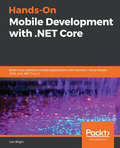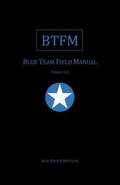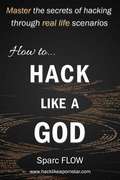- Table View
- List View
Transferring Information Literacy Practices
by Billy Tak Leung Jingzhen Xie Linlin Geng Priscilla Nga PunThis book focuses on information literacy for the younger generation of learners and library readers. It is divided into four sections: 1. Information Literacy for Life; 2. Searching Strategies, Disciplines and Special Topics; 3. Information Literacy Tools for Evaluating and Utilizing Resources; 4. Assessment of Learning Outcomes. Written by librarians with wide experience in research and services, and a strong academic background in disciplines such as the humanities, social sciences, information technology, and library science, this valuable reference resource combines both theory and practice. In today's ever-changing era of information, it offers students of library and information studies insights into information literacy as well as learning tips they can use for life.
Smart Education and e-Learning 2019 (Smart Innovation, Systems and Technologies #144)
by Lakhmi C. Jain Robert J. Howlett Vladimir L. UskovThis book contains the contributions presented at the 6th international KES conference on Smart Education and e-Learning (KES SEEL-2019), which took place at St. Julian’s, Malta, June 17–19, 2019. It contains fifty-five high-quality peer-reviewed papers that are grouped into several interconnected parts: Part 1 – Smart Education, Part 2 – Smart e-Learning, Part 3 – Smart Pedagogy, Part 4 – Smart Education: Systems and Technology, Part 5 – Smart Education: Case Studies and Research, Part 6 – Students with Disabilities and Smart Education/University, and Part 7 – Mathematical Modelling of Smart Education and Economics of Smart University. Smart education and smart e-learning are emerging and rapidly growing areas with the potential to transform existing teaching strategies, learning environments, and educational activities and technology in the classroom. Smart education and smart e-learning focus on enabling instructors to develop new ways of achieving excellence in teaching in highly technological smart classrooms, and providing students with new opportunities to maximize their success and select the best options for their education, location and learning style, as well as the mode of content delivery. This book serves as a useful source of research data and valuable information on current research projects, best practices and case studies for faculty, scholars, Ph.D. students, administrators, and practitioners – all those who are interested in smart education and smart e-learning.
Principles of Radio Navigation for Ground and Ship-Based Aircrafts (Springer Aerospace Technology)
by Sauta O.I. Shatrakov A.Y. Shatrakov Y.G. Zavalishin O.I.This book systematically presents the operating principles and technical characteristics of the main radio navigating systems (RNSs) that make it possible to adequately evaluate the corresponding scratch indexes and levels of air safety for air vehicles, the chief concern of the International Civil Aviation Organization (ICAO). The book discusses how RNS systems substantially determine navigation accuracy and reliability, and therefore air safety; in addition, it presents practical solutions to problems arising in the operation and development of RNS systems.
Cooperative Tracking Control and Regulation for a Class of Multi-agent Systems
by Huaguang Zhang Hongjing LiangThis book focuses on the characteristics of cooperative control problems for general linear multi-agent systems, including formation control, air traffic control, rendezvous, foraging, role assignment, and cooperative search. On this basis and combined with linear system theory, it introduces readers to the cooperative tracking problem for identical continuous-time multi-agent systems under state-coupled dynamics; the cooperative output regulation for heterogeneous multi-agent systems; and the optimal output regulation for model-free multi-agent systems. In closing, the results are extended to multiple leaders, and cooperative containment control for uncertain multi-agent systems is addressed. Given its scope, the book offers an essential reference guide for researchers and designers of multi-agent systems, as well as a valuable resource for upper-level undergraduate and graduate students.
Modeling and Simulation of Invasive Applications and Architectures (Computer Architecture and Design Methodologies)
by Frank Hannig Jürgen Teich Sascha RoloffThis book covers two main topics: First, novel fast and flexible simulation techniques for modern heterogeneous NoC-based multi-core architectures. These are implemented in the full-system simulator called InvadeSIM and designed to study the dynamic behavior of hundreds of parallel application programs running on such architectures while competing for resources. Second, a novel actor-oriented programming library called ActorX10, which allows to formally model parallel streaming applications by actor graphs and to analyze predictable execution behavior as part of so-called hybrid mapping approaches, which are used to guarantee real-time requirements of such applications at design time independent from dynamic workloads by a combination of static analysis and dynamic embedding.
Pro Oracle Database 18c Administration: Manage and Safeguard Your Organization’s Data
by Darl Kuhn Michelle MalcherDatabase administration isn’t about passing a certified exam, or about pointing and clicking your way through a crisis. Database administration is about applying the right solution at the right time, avoiding risk, and making robust choices that get you home each night in time for dinner with your family. This book will help elevate you to the level of Professional Oracle Database Administrator.This book provides information and techniques for keeping an Oracle database stable and running on-premise, and is fully updated to cover Oracle Database 18c. New in this edition is coverage of cloud administration in the Oracle Public Cloud, automation of tasks using the autonomous database features, and data movement with multi-tenant databases. The book covers everything from architecture of the database engine, securing objects and users, strategies for performing maintenance tasks and resolving performance problems, through to backup and recovery. Pro Oracle Database 18c Administration takes a modern approach to database administration. Emphasis is given to automation, which is of growing importance as more databases are being moved into various cloud solutions and database administrators are being required to manage more instances than ever. Focus is given to multi-tenant container architecture and pluggable databases, and the book takes a refreshing, results-oriented approach that helps you get the job done. What You'll LearnUnderstand the differences between managing on-premise and cloud deploymentsTake advantage of new features in 18c while also managing older releasesManage more databases than ever by automating your environmentApply the latest techniques around pluggable databases and containerizationSafeguard your data through good security and backup/recovery practicesTroubleshoot common problemsWho This Book Is ForDatabase architects and administrators who want to level-up to the latest techniques around containerization, automation, and cloud deployment. The book also is appropriate for Oracle professionals desiring to present themselves as being competitive and up-to-date with the latest in the field.
High-Performance Simulation-Based Optimization (Studies in Computational Intelligence #833)
by El-Ghazali Talbi Peter Korošec Thomas Bartz-Beielstein Bogdan FilipičThis book presents the state of the art in designing high-performance algorithms that combine simulation and optimization in order to solve complex optimization problems in science and industry, problems that involve time-consuming simulations and expensive multi-objective function evaluations. As traditional optimization approaches are not applicable per se, combinations of computational intelligence, machine learning, and high-performance computing methods are popular solutions. But finding a suitable method is a challenging task, because numerous approaches have been proposed in this highly dynamic field of research. That’s where this book comes in: It covers both theory and practice, drawing on the real-world insights gained by the contributing authors, all of whom are leading researchers. Given its scope, if offers a comprehensive reference guide for researchers, practitioners, and advanced-level students interested in using computational intelligence and machine learning to solve expensive optimization problems.
Professional WordPress Plugin Development
by Brad Williams Ozh Richard Justin TadlockTaking WordPress to the next level with advanced plugin development WordPress is used to create self-hosted blogs and sites, and it's fast becoming the most popular content management system (CMS) on the Web. Now you can extend it for personal, corporate and enterprise use with advanced plugins and this professional development guide. Learn how to create plugins using the WordPress plugin API: utilize hooks, store custom settings, craft translation files, secure your plugins, set custom user roles, integrate widgets, work with JavaScript and AJAX, create custom post types. You'll find a practical, solutions-based approach, lots of helpful examples, and plenty of code you can incorporate! Shows you how to develop advanced plugins for the most popular CMS platform today, WordPress Covers plugin fundamentals, how to create and customize hooks, internationalizing your site with translation files, securing plugins, how to create customer users, and ways to lock down specific areas for use in corporate settings Delves into advanced topics, including creating widgets and metaboxes, debugging, using JavaScript and AJAX, Cron integration, custom post types, short codes, multi site functions, and working with the HTTP API Includes pointers on how to debug, profile and optimize your code, and how to market your custom plugin Learn advanced plugin techniques and extend WordPress into the corporate environment.
Discrete Fuzzy Measures: Computational Aspects (Studies in Fuzziness and Soft Computing #382)
by Simon James Gleb Beliakov Jian-Zhang WuThis book addresses computer scientists, IT specialists, mathematicians, knowledge engineers and programmers, who are engaged in research and practice of multicriteria decision making. Fuzzy measures, also known as capacities, allow one to combine degrees of preferences, support or fuzzy memberships into one representative value, taking into account interactions between the inputs. The notions of mutual reinforcement or redundancy are modeled explicitly through coefficients of fuzzy measures, and fuzzy integrals, such as the Choquet and Sugeno integrals combine the inputs. Building on previous monographs published by the authors and dealing with different aspects of aggregation, this book especially focuses on the Choquet and Sugeno integrals. It presents a number of new findings concerning computation of fuzzy measures, learning them from data and modeling interactions. The book does not require substantial mathematical background, as all the relevant notions are explained. It is intended as concise, timely and self-contained guide to the use of fuzzy measures in the field of multicriteria decision making.
Programming Languages and Systems: 28th European Symposium on Programming, ESOP 2019, Held as Part of the European Joint Conferences on Theory and Practice of Software, ETAPS 2019, Prague, Czech Republic, April 6–11, 2019, Proceedings (Lecture Notes in Computer Science #11423)
by Luís CairesThis open access book constitutes the proceedings of the 28th European Symposium on Programming, ESOP 2019, which took place in Prague, Czech Republic, in April 2019, held as Part of the European Joint Conferences on Theory and Practice of Software, ETAPS 2019.
Research Methods For Business Students
by Mark Saunders Philip Lewis Adrian ThornhillA comprehensive introduction to research methods in business for students planning or undertaking a dissertation or extensive research project in business and management. <P><P> The fifth edition of Research Methods for Business Students brings the theory, philosophy and techniques of research to life and enables students to understand the practical relevance of the research methods. A highly accessible style and logical structure have made this the 'student choice' and run-away market leader. <P><P> The book is written for students on undergraduate and postgraduate degree programmes in business, or business-related disciplines. <P><P> The following online resources support the text: <P><P> For Students: self-assessment questions, glossary, revision "flashcards", tutorials for SPSS and NVivo, plus Smarter Online Searching Guide For Instructors: teaching manual, powerpoint slides, testbank
Hacker, Hoaxer, Whistleblower, Spy: The Many Faces of Anonymous
by Gabriella ColemanHere is the ultimate book on the worldwide movement of hackers, pranksters, and activists that operates under the non-name Anonymous, by the writer the Huffington Post says "knows all of Anonymous' deepest, darkest secrets."Half a dozen years ago, anthropologist Gabriella Coleman set out to study the rise of this global phenomenon just as some of its members were turning to political protest and dangerous disruption (before Anonymous shot to fame as a key player in the battles over WikiLeaks, the Arab Spring, and Occupy Wall Street). She ended up becoming so closely connected to Anonymous that the tricky story of her inside-outside status as Anon confidante, interpreter, and erstwhile mouthpiece forms one of the themes of this witty and entirely engrossing book.The narrative brims with details unearthed from within a notoriously mysterious subculture, whose semi-legendary tricksters--such as Topiary, tflow, Anachaos, and Sabu--emerge as complex, diverse, politically and culturally sophisticated people. Propelled by years of chats and encounters with a multitude of hackers, including imprisoned activist Jeremy Hammond and the double agent who helped put him away, Hector Monsegur, Hacker, Hoaxer, Whistleblower, Spy is filled with insights into the meaning of digital activism and little understood facets of culture in the Internet age, including the history of "trolling," the ethics and metaphysics of hacking, and the origins and manifold meanings of "the lulz."
Hacking: The Underground Guide To Computer Hacking, Including Wireless Networks, Security, Windows, Kali Linux And Penetration Testing
by Abraham WhiteThis book will provide you with the best tools for hacking and also point out ways you can protect your systems. Step by Step instructions with command prompts are included.
Single-DC-Source Multilevel Inverters (SpringerBriefs in Electrical and Computer Engineering)
by Hani Vahedi Mohamed TrabelsiThe purpose of the book is to distinguish the single-de-source multilevel inverter topologies and to teach their control, switching and voltage balancing. It will include new information on voltage balancing and control of multilevel inverters. The book will answer some important questions about the revolution of power electronics converters: 1- Why multilevel inverter are better than 2-level ones? 2- Why single-de-source multilevel inverters are a matter of interest? 3- What are the redundant switching states and what do they do? 4- How to use redundant switching states in control and voltage balancing? 5- What are the applications of single-de-source multilevel inverters?
Security and Safety Interplay of Intelligent Software Systems: ESORICS 2018 International Workshops, ISSA 2018 and CSITS 2018, Barcelona, Spain, September 6–7, 2018, Revised Selected Papers (Lecture Notes in Computer Science #11552)
by Yuval Elovici Asaf Shabtai Joaquin Garcia-Alfaro Barbara Gallina Brahim HamidThis book constitutes the thoroughly refereed post-conference proceedings of the International Workshop on Interplay of Security, Safety and System/Software Architecture, CSITS 2018, and the International Workshop on Cyber Security for Intelligent Transportation Systems, ISSA 2018, held in Barcelona, Spain, in September 2018, in conjunction with the 23rd European Symposium on Research in Computer Security, ESORICS 2018.The ISSA 2018 workshop received 10 submissions from which 3 full papers and 1 short paper were accepted. They cover topics such as software security engineering, domain-specific security and privacy architectures, and automative security. In addition, an invited paper on safety and security co-engineering intertwining is included. The CSITS 2018 workshop received 9 submissions from which 5 full papers and 1 short paper were accepted. The selected papers deal with car security and aviation security.
Applied Reconfigurable Computing: 15th International Symposium, ARC 2019, Darmstadt, Germany, April 9–11, 2019, Proceedings (Lecture Notes in Computer Science #11444)
by Roger Woods Christian Hochberger Brent Nelson Andreas Koch Pedro DinizThis book constitutes the proceedings of the 15th International Symposium on Applied Reconfigurable Computing, ARC 2019, held in Darmstadt, Germany, in April 2019. The 20 full papers and 7 short papers presented in this volume were carefully reviewed and selected from 52 submissions. In addition, the volume contains 1 invited paper. The papers were organized in topical sections named: Applications; partial reconfiguration and security; image/video processing; high-level synthesis; CGRAs and vector processing; architectures; design frameworks and methodology; convolutional neural networks.
Public-Key Cryptography – PKC 2019: 22nd IACR International Conference on Practice and Theory of Public-Key Cryptography, Beijing, China, April 14-17, 2019, Proceedings, Part I (Lecture Notes in Computer Science #11442)
by Dongdai Lin Kazue SakoThe two-volume set LNCS 11442 and 11443 constitutes the refereed proceedings of the 22nd IACR International Conference on the Practice and Theory of Public-Key Cryptography, PKC 2019, held in Beijing, China, in April 2019. The 42 revised papers presented were carefully reviewed and selected from 173 submissions. They are organized in topical sections such as: Cryptographic Protocols; Digital Signatures; Zero-Knowledge; Identity-Based Encryption; Fundamental Primitives; Public Key Encryptions; Functional Encryption; Obfuscation Based Cryptography; Re- Encryption Schemes; Post Quantum Cryptography.
Persuasive Technology: 14th International Conference, PERSUASIVE 2019, Limassol, Cyprus, April 9–11, 2019, Proceedings (Lecture Notes in Computer Science #11433)
by Harri Oinas-Kukkonen Evangelos Karapanos Khin Than Win Pasi Karppinen Eleni KyzaThis book constitutes the refereed proceedings of the 14th International Conference on Persuasive Technology, PERSUASIVE 2019, held in Limassol, Cyprus, in April 2019. The 29 full papers presented were carefully reviewed and selected from 79 submissions. The papers demonstrate how persuasive technologies can help solve societal issues. They were subsequently grouped in the following topical sections: Terminologies and methodologies; self-monitoring and reflection; systems development process; drones and automotives; ethical and legal aspects; special application domains; motivation and goal setting; personality, age and gender; social support; user types and tailoring.
Advances in National Brand and Private Label Marketing: Sixth International Conference, 2019 (Springer Proceedings in Business and Economics)
by Francisco J. Martínez-López Juan Carlos Gázquez-Abad Anne RoggeveenThe 2019 International Conference on National Brand & Private Label Marketing is a unique academic forum for presenting and discussing original, rigorous and significant contributions from researchers around the world on marketing issues that retailers, store brand managers and national brand managers are facing.The three-day event covered a wide range of topics from varied fields including retailing, marketing, general business, psychology, economics and statistics. Further, it addressed diverse areas of application such as innovation, retail market structure, social media, consumer decision-making, store loyalty, assortment size, digital transformation, ethical aspects, cultural dimensions, and private label pricing. This volume gathers the proceedings of the 2019 NB&PL marketing conference in a collection of outstanding contributions that employ a wide variety of theoretical and methodological approaches.
Advances in Human Factors, Business Management and Leadership: Proceedings Of The Ahfe 2017 Conference On Human Factors, Business Management And Society And The Ahfe 2017 Conference On Human Factors In Management And Leadership, July 17-21, 2017, Los Angeles, California, Usa (Advances in Intelligent Systems and Computing #594)
by Jussi Ilari Kantola Salman NazirThis book presents practical approaches for facilitating the achievement of excellence in the management and leadership of organizational resources. It shows how the principles of creating shared value can be applied to ensure faster learning, training, business development, and social renewal. In particular, it presents novel methods and tools for tackling the complexity of management and learning in both business organizations and society. Discussing ontologies, intelligent management systems, methods for creating knowledge and value added, it offers novel insights into time management and operations optimization, as well as advanced methods for evaluating customers’ satisfaction and conscious experience. Based on two conferences, the AHFE 2019 International Conference on Human Factors, Business Management and Society, and the AHFE 2019 International Conference on Human Factors in Management and Leadership, held in July 24-28, 2019, Washington D.C., USA, the book provides both researchers and professionals with new tools and inspiring ideas for achieving excellence in various business activities.
Hands-On Mobile Development with .NET Core: Build cross-platform mobile applications with Xamarin, Visual Studio 2019, and .NET Core 3
by Can BilginDevelop native applications for multiple mobile and desktop platforms including but not limited to iOS, Android, and UWP with the Xamarin framework and Xamarin.FormsKey FeaturesUnderstand .NET Core and its cross-platform development philosophy Build Android, iOS, and Windows mobile applications with C#, .NET Core, and Azure Cloud ServicesBring Artificial Intelligence capabilities into your mobile applications with Azure AIBook Description.NET Core is the general umbrella term used for Microsoft’s cross-platform toolset. Xamarin used for developing mobile applications, is one of the app model implementations for .NET Core infrastructure. In this book, you will learn how to design, architect, and develop highly attractive, maintainable, efficient, and robust mobile applications for multiple platforms, including iOS, Android, and UWP, with the toolset provided by Microsoft using Xamarin, .NET Core, and Azure Cloud Services. This book will take you through various phases of application development with Xamarin, from environment setup, design, and architecture to publishing, using real-world scenarios. Throughout the book, you will learn how to develop mobile apps using Xamarin, Xamarin.Forms and .NET Standard; implement a webbased backend composed of microservices with .NET Core using various Azure services including but not limited to Azure App Services, Azure Active Directory, Notification Hub, Logic Apps, and Azure Functions, Cognitive Services; create data stores using popular database technologies such as Cosmos DB, SQL and Realm.Towards the end, the book will help developers to set up an efficient and maintainable development pipeline to manage the application life cycle using Visual Studio App Center and Visual Studio Services.What you will learnImplement native applications for multiple mobile and desktop platformsUnderstand and use various Azure Services with .NET CoreMake use of architectural patterns designed for mobile and web applicationsUnderstand the basic Cosmos DB conceptsUnderstand how different app models can be used to create an app serviceExplore the Xamarin and Xamarin.Forms UI suite with .NET Core for building mobile applicationsWho this book is forThis book is for mobile developers who wish to develop cross-platform mobile applications. Programming experience with C# is required. Some knowledge and understanding of core elements and cross-platform application development with .NET is required.
Blue Team Field Manual (RFTM Series)
by Alan White Ben ClarkBlue Team Field Manual (BTFM) is a Cyber Security Incident Response Guide that aligns with the NIST Cybersecurity Framework consisting of the five core functions of Identify, Protect, Detect, Respond, and Recover by providing the tactical steps to follow and commands to use when preparing for, working through and recovering from a Cyber Security Incident.
Hash Crack: Password Cracking Manual (V3 Series)
by Joshua PicoletThe Hash Crack: Password Cracking Manual v3 is an expanded reference guide for password recovery (cracking) methods, tools, and analysis techniques. A compilation of basic and advanced techniques to assist penetration testers and network security professionals evaluate their organization's posture. The Hash Crack manual contains syntax and examples for the most popular cracking and analysis tools and will save you hours of research looking up tool usage. It also includes basic cracking knowledge and methodologies every security professional should know when dealing with password attack capabilities. Hash Crack contains all the tables, commands, online resources, and more to complete your cracking security kit. This version expands on techniques to extract hashes from a myriad of operating systems, devices, data, files, and images. Lastly, it contains updated tool usage and syntax for the most popular cracking tools.
How To Hack Like A God: Master The Secrets Of Hacking Through Real Life Scenarios (Hack The Planet Ser.)
by Sparc FlowFollow me on a step-by-step hacking journey where we pwn a high-profile fashion company. From zero initial access to remotely recording board meetings, we will detail every custom script and technique used in this attack, drawn from real-life findings, to paint the most realistic picture possible. Whether you are a wannabe pentester dreaming about real-life hacking experiences or an experienced ethical hacker tired of countless Metasploit tutorials, you will find unique gems in this book for you to try: -Playing with Kerberos -Bypassing Citrix & Applocker -Mainframe hacking -Fileless WMI persistence -NoSQL injections -Wiegand protocol -Exfiltration techniques -Antivirus evasion tricks -And much more advanced hacking techniques I have documented almost every tool and custom script used in this book. I strongly encourage you to test them out yourself and master their capabilities (and limitations) in an environment you own and control. Hack (safely) the Planet! (Previously published as How to Hack a Fashion Brand)
CEH v10 Certified Ethical Hacker Study Guide
by Ric MessierAs protecting information becomes a rapidly growing concern for today’s businesses, certifications in IT security have become highly desirable, even as the number of certifications has grown. Now you can set yourself apart with the Certified Ethical Hacker (CEH v10) certification. The CEH v10 Certified Ethical Hacker Study Guide offers a comprehensive overview of the CEH certification requirements using concise and easy-to-follow instruction. Chapters are organized by exam objective, with a handy section that maps each objective to its corresponding chapter, so you can keep track of your progress. The text provides thorough coverage of all topics, along with challenging chapter review questions and Exam Essentials, a key feature that identifies critical study areas. Subjects include intrusion detection, DDoS attacks, buffer overflows, virus creation, and more. This study guide goes beyond test prep, providing practical hands-on exercises to reinforce vital skills and real-world scenarios that put what you’ve learned into the context of actual job roles. Gain a unique certification that allows you to understand the mind of a hacker Expand your career opportunities with an IT certificate that satisfies the Department of Defense’s 8570 Directive for Information Assurance positions Fully updated for the 2018 CEH v10 exam, including the latest developments in IT security Access the Sybex online learning center, with chapter review questions, full-length practice exams, hundreds of electronic flashcards, and a glossary of key terms Thanks to its clear organization, all-inclusive coverage, and practical instruction, the CEH v10 Certified Ethical Hacker Study Guide is an excellent resource for anyone who needs to understand the hacking process or anyone who wants to demonstrate their skills as a Certified Ethical Hacker.
